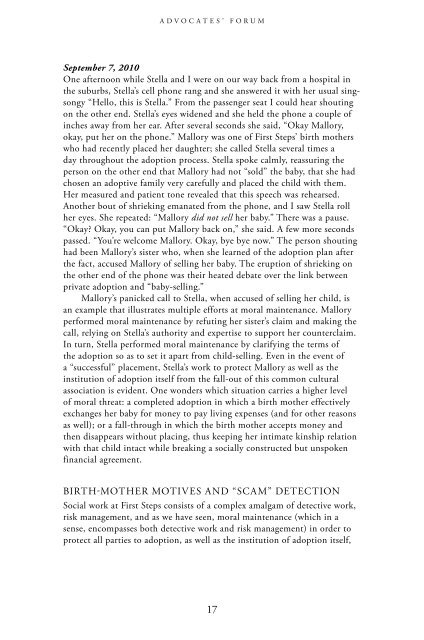DEFINING PROBLEMS. SHAPING SOLUTIONS . - School of Social Service ...
DEFINING PROBLEMS. SHAPING SOLUTIONS . - School of Social Service ...
DEFINING PROBLEMS. SHAPING SOLUTIONS . - School of Social Service ...
Create successful ePaper yourself
Turn your PDF publications into a flip-book with our unique Google optimized e-Paper software.
a d v o c a t e s ’ f o r u m<br />
September 7, 2010<br />
One afternoon while Stella and I were on our way back from a hospital in<br />
the suburbs, Stella’s cell phone rang and she answered it with her usual singsongy<br />
“Hello, this is Stella.” From the passenger seat I could hear shouting<br />
on the other end. Stella’s eyes widened and she held the phone a couple <strong>of</strong><br />
inches away from her ear. After several seconds she said, “Okay Mallory,<br />
okay, put her on the phone.” Mallory was one <strong>of</strong> First Steps’ birth mothers<br />
who had recently placed her daughter; she called Stella several times a<br />
day throughout the adoption process. Stella spoke calmly, reassuring the<br />
person on the other end that Mallory had not “sold” the baby, that she had<br />
chosen an adoptive family very carefully and placed the child with them.<br />
Her measured and patient tone revealed that this speech was rehearsed.<br />
Another bout <strong>of</strong> shrieking emanated from the phone, and I saw Stella roll<br />
her eyes. She repeated: “Mallory did not sell her baby.” There was a pause.<br />
“Okay? Okay, you can put Mallory back on,” she said. A few more seconds<br />
passed. “You’re welcome Mallory. Okay, bye bye now.” The person shouting<br />
had been Mallory’s sister who, when she learned <strong>of</strong> the adoption plan after<br />
the fact, accused Mallory <strong>of</strong> selling her baby. The eruption <strong>of</strong> shrieking on<br />
the other end <strong>of</strong> the phone was their heated debate over the link between<br />
private adoption and “baby-selling.”<br />
Mallory’s panicked call to Stella, when accused <strong>of</strong> selling her child, is<br />
an example that illustrates multiple efforts at moral maintenance. Mallory<br />
performed moral maintenance by refuting her sister’s claim and making the<br />
call, relying on Stella’s authority and expertise to support her counterclaim.<br />
In turn, Stella performed moral maintenance by clarifying the terms <strong>of</strong><br />
the adoption so as to set it apart from child-selling. Even in the event <strong>of</strong><br />
a “successful” placement, Stella’s work to protect Mallory as well as the<br />
institution <strong>of</strong> adoption itself from the fall-out <strong>of</strong> this common cultural<br />
association is evident. One wonders which situation carries a higher level<br />
<strong>of</strong> moral threat: a completed adoption in which a birth mother effectively<br />
exchanges her baby for money to pay living expenses (and for other reasons<br />
as well); or a fall-through in which the birth mother accepts money and<br />
then disappears without placing, thus keeping her intimate kinship relation<br />
with that child intact while breaking a socially constructed but unspoken<br />
financial agreement.<br />
Birth-Mother Motives and “Scam” Detection<br />
<strong>Social</strong> work at First Steps consists <strong>of</strong> a complex amalgam <strong>of</strong> detective work,<br />
risk management, and as we have seen, moral maintenance (which in a<br />
sense, encompasses both detective work and risk management) in order to<br />
protect all parties to adoption, as well as the institution <strong>of</strong> adoption itself,<br />
17
















